
28 minute read
Technical
Of all 454 tree species native to the European region, 168 are considered threatened, with 34 of those native to the UK
Xylella fastidiosa is a disease-causing bacterium that is the main concern for future infections Phytophtora ramorum shows how devastating pests and diseases can be to our local flora. Since its discovery in the UK, in 2002, it led to the mass destruction of larch trees.

Plant health more on
Written by Emily Magdij
the agenda than ever Marketing and Communications Officer
With climate change, the advent of Brexit and changing biosecurity protocols, plant health is in the spotlight more than ever before. Over 500,000 jobs in the ornamental horticulture industry rely on good plant health, and an estimated £9bn value to the economy is provided through our plants and trees. With all that at stake, it is important the sector stays vigilant to the threats posed by non-native plants, diseases and plant pests.
Of all 454 tree species native to the European region, 168 are considered threatened, with 34 of those native to the UK. Invasive and problematic species have been identified as the highest threat to the UK’s trees – higher than deforestation, wood harvesting, and urban development.

There are 127 plant pests and diseases that are considered high risk to the UK, with several presenting serious danger to our native plant life.
Phytophtora ramorum shows how devastating pests and diseases can be to our local flora. After being first discovered in the UK in 2002, it led to the mass destruction of larch trees. Before its discovery there were approximately 154,000 hectares of larch planted in Great Britain, or 5% of the total area – most of this has now been lost because of the disease, and the timber industry has been affected by no longer being able to use larch as a species.
Ash dieback is a fungal disease, originally from Asia, that is thought to have been brought to the UK on infected, imported trees. It is currently ravaging our ash trees and is expected to kill between 95% and 99% of all ash in Britain. The total cost of the disease to the UK is estimated to be £15bn – a third more than the reported cost of the foot-and-mouth disease outbreak in 2001.
Xylella fastidiosa is a diseasecausing bacterium that can affect many woody plants including broadleaved trees and is the main concern for future infections. Though not currently found in the UK, an outbreak is likely to result in the destruction of host plants within 100m and a 5km movement ban for ‘specified’ plants for five years.
With plant health so important to the industry and to the UK’s flora, horticulturists and importers are urged to take extra care to familiarise themselves with the UK’s new biosecurity protocols. These new, post-Brexit systems are covered in more detail in this issue of Landscape News on pages 28 and 29.
Visit bali.org.uk/help-and-advice/ plant-health for more information.
Making every
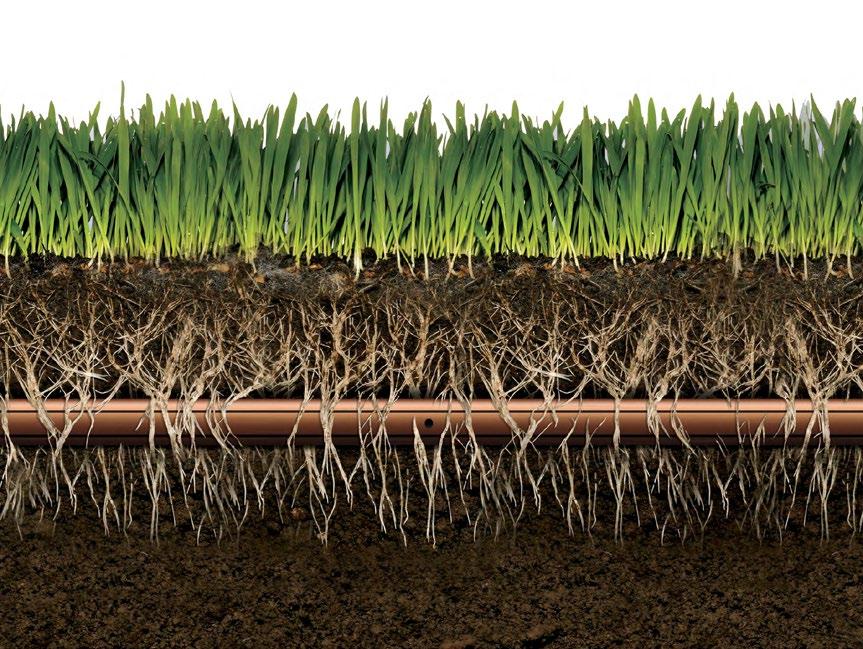
drop count! Written by Accredited Supplier Rigby Taylor
Landscape irrigation is more than just dropping a sprinkler on a stand in the middle of a lawn or connecting a hosepipe to a dripline for valued plants. Today’s technology means that there are many options to irrigation grassed surfaces, from individual specimen plants to blanket grass coverage.

Whether you are a major contractor with a budget of thousands or a local landscape company called in for a small garden project, a professionally installed irrigation system will provide plants with the right amount of water at the time they need it the most.
Selecting the right irrigation system can be tricky. If the property has large bushes, then sprinkler coverage can be hampered because of the shadowing effect, and no one wants their prize rose blooms to get water spots either! Sprinkler irrigation can also sometimes lead to foliar diseases. In situations such as this, dripline irrigation can be a great alternative.
What exactly is dripline?
Don’t confuse it with leaky hose, or drippers plugged into a garden pipe. Its full name is Pressure Compensating Dripline and has drippers extruded inside the tube wall and properly installed will be difficult to spot; the preference is for them to be spaced every 30cm, but you can get driplines with emitters every 45cm.
The dripline tube is 17mm wide and comes in coils of up to 100 metres. Each emitter will allow exactly 2.3 litres of water to be emitted per hour. It is extremely accurate and has been used for decades in the horticulture industry.
Dripline pipes come in coils of 100 metre lengths.
There are two different types of Rain Bird dripline; the standard on-thesurface dripline (model XFD) can be covered by mulch making it almost impossible to see.
The other option (model XFS) is for the dripline to be buried under the soil surface. This sub-surface dripline can also be used to irrigate lawns.
Driplines are a perfect option for landscape gardens and very simple to install. All that is required is for the dripline to be laid out across the garden surface, pegged down every metre and connected to a feeder pipe.
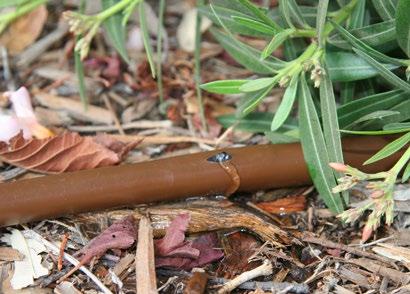
XFD dripline laid above soil
The fittings such as joiners, elbows and tee junctions are cheap and very simple to install. The key is to maximise the coverage of water and to achieve this the best way is to install the dripline
XFS sub-surface dripline
in a grid pattern with ideally grid rows no further apart than 40cm. This means that any plant within the garden has only 20cm between the rows or 15cm along the dripline to find water. The best time to install it is after the larger plants have been planted but before the placement of the smaller ones. As above, a mulch such as bark can be applied on top which hides it from view.
Hopefully, if someone wants to dig a hole for a new plant, the first thing to do is scrape the mulch away and see the dripline before they put the spade through it! Even if they do cut the pipe, a dripline joiner costs less than a pound and is an easy fix homeowners can perform themselves.
Keeping tabs of the flow rate of your dripline system is important. Each emitter provides 2.3 litres per hour to the garden.

Driplines with internal emitters control the water emission to 2.3 litres/hour
If you use 30cm dripline then this means that every metre of dripline you install has just over 3 emitters (one every 30cm), with a flow rate of just under 8 litres per hour. If you install 100 metres of it, your water supply (i.e., the tap or pump) therefore needs to supply at least 800 litres per hour.
Obviously, dripline has its place; they are not great if you want to create a tropical garden, and if you’re planting annuals and bedding plants they’ll need to be well watered for a few days until they learn to grow their roots in the moist soil. For most permanent gardens in the UK though, dripline is by far the most accurate means of irrigating gardens.
For more information on Pressure Compensating Dripline visit rigbytaylor.com.
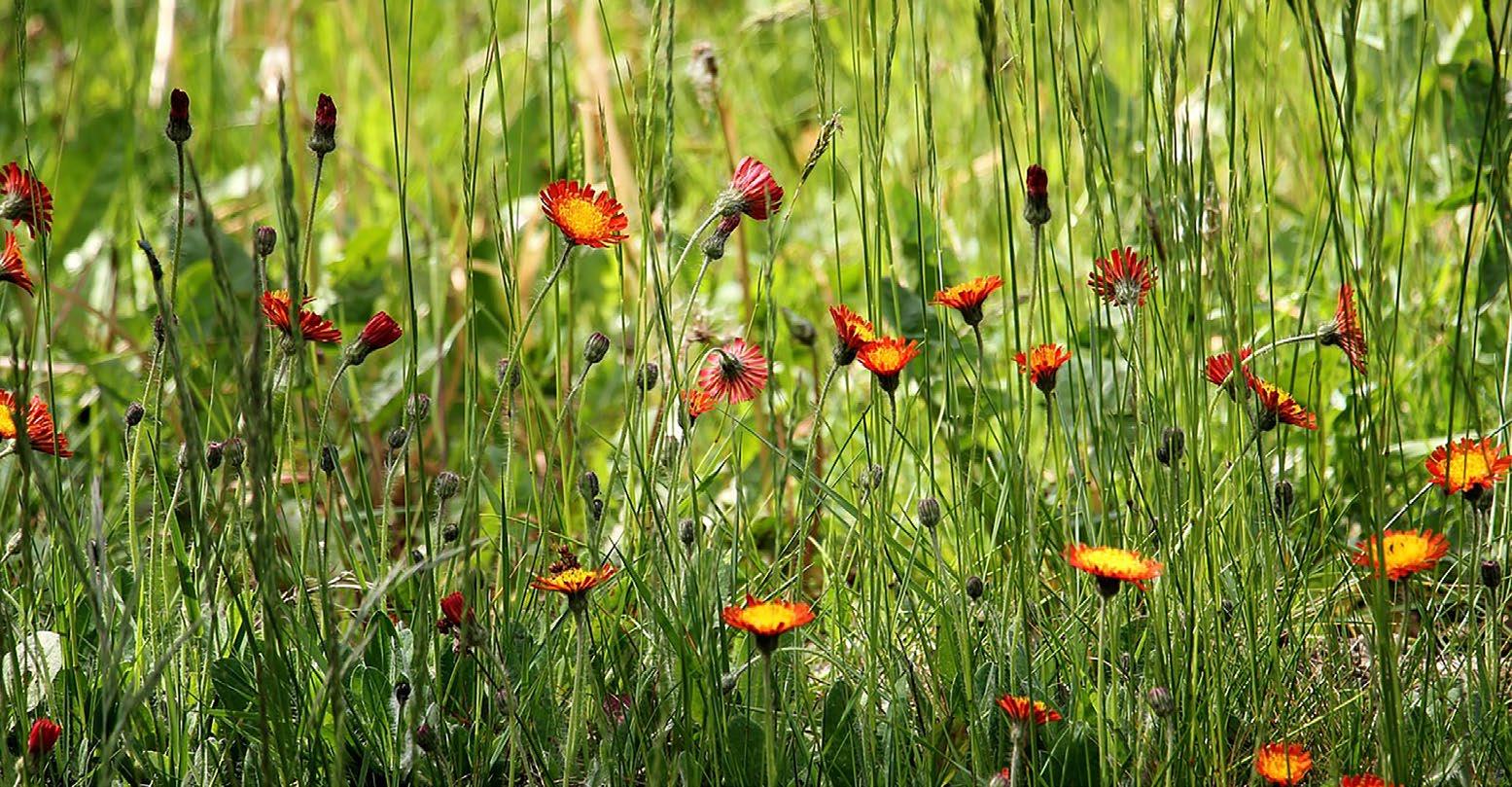

No Mow May. And June. And July. And August. And September?
Reduced frequency of mowing in grassed areas of all sizes and locations is gaining popularity amongst commercial, domestic, and public custodians of land. The initiative, widely advocated by ecologists and conservationists, is resulting in grassland areas traditionally managed by programme of 25 – 35 grass cuts per year being allowed to grow much longer between cuts.
The catalyst for this change is a renewed focus on management of the urban environment; how it can be modified to maximise benefits to people but also local ecology. Research suggests regular grass mowing suppresses the range of insect species in a given area, and that mowing the same area each month has the effect of reducing diversity of insects by roughly 50% per mowing event.
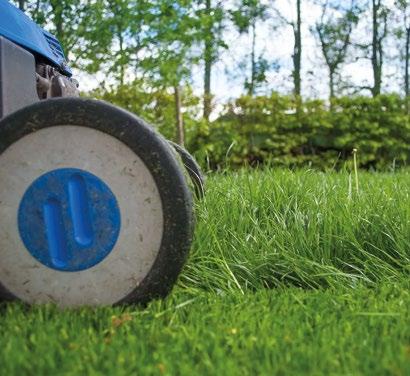
One of the main reasons for this lack of insect diversity is the way in which frequent mowing reduces the number of annual grass species, by impeding their ability to reach a reproductive state e.g., flower and seed stages. This lack of variety in grass species limits insect diversity and number.
Research suggests grass subject to a more relaxed mowing regime supports far more flora and fauna and supplies greater benefits to people per given area than those which are subject to a more formal or intensive mowing regime.
There is no limit to the type of site, with recent examples ranging from public open spaces such as parks and recreation fields, to verges adjacent to trunk roads and rail lines, as well as domestic gardens.
Mowing regimes which aim to enrich diversity of species may be seen as a scaled-down interpretation of the conservation technique termed ‘re-wilding’, practiced by professional ecologists and successfully implemented on various sites worldwide. Whilst the scale of most urban grassland areas is considerably
Written by Owen Baker
Technical Officer (Policy & Research)
smaller than rewilding sites and, due to their location, management is likely to be more controlled and on a shorter time scale, the principles are broadly similar.
The outcomes are not dissimilar either; research has demonstrated that, even in small, localised sites within urban parks or domestic gardens, a reduction in mowing regimes can have a positive effect on biomass and biodiversity and that, if allowed to grow, meadow-like areas of grass inside urban parks have the same positive effects as natural meadows in rural areas.
Scientific research carried out on various managed grassland sites in the UK supports the theory that even a slightly reduced frequency of mowing, for example from every week to every month or two, can benefit flora and fauna significantly.
A transition from short, frequently mown areas to a more meadow-like regime where species can grow, flower and set seed in spring and summer has a positive effect on the biodiversity of arthropod insects which include ants, aphids, beetles, butterflies and dragonflies. Research suggests any measures to make grasslands more complex are also

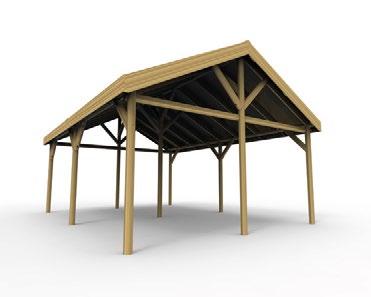
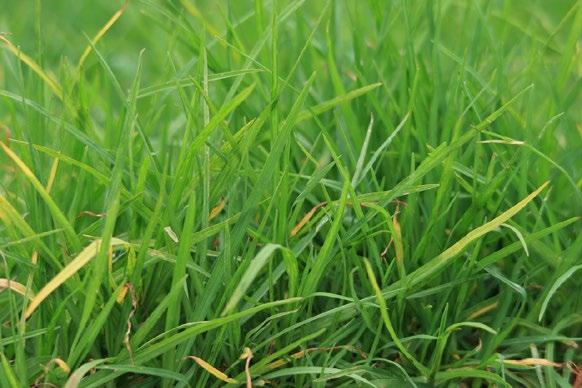

likely to have positive knock-on effects such as a more diverse bird community and will favour pollinators who rely on urban areas for food sources.
Whilst covering a smaller area than parks or even roadside verges, domestic gardens represent an important aspect of urban ecosystems which, whilst offering fewer ecosystem services than natural areas, can be similarly maintained to offer benefits to wildlife through simple interventions such as reducing mowing frequency.

Aside from the benefits to insect diversity, research on urban temperatures suggests the surface of short-mown grass is warmer by an average of 5°C than areas of a garden with taller, denser vegetation. Grass allowed to grow even slightly longer offers an accessible and low-cost intervention to mitigate the effects of urban heat, particularly where tree or shrub planting is not practical.
Reduced frequency of mowing has not been met with universal acceptance; some regard longer grass as unsightly or even dangerous in urban areas. Whilst there is no denying localised areas of highway verges must be mown regularly to maintain sight-lines for signage or forward-visibility, recent research suggests there is no link between vegetation and higher crime rates.
Numerous studies suggest the greener an urban area is, the fewer crimes – both property and violent crimes – were reported. Like with highways safety, providing paths are not overgrown, there is no reason why green infrastructure should pose a greater risk.

Owen Baker - Technical Officer (Policy & Research) • Portfolio of timber shelters and classrooms
• Manufactured from premium grade PlayGuard® timbers • CAD modelled with a range of standard and bespoke sizes • Infill panel range includes white board, chalkboard, palisade or solid timber • Bench seating can be manufactured and supplied • Install with standard timber legs or alternative steel feet
Forest Pavilions

Modular Gazebos
Pergola Shelters

Unilog Pro machine round timbers offer an attractive, practical and cost-effective solution for landscape projects. Timbers are kiln dried and pressure treated with Tanalith E wood preservative.
Ideal for
• Earth retaining walls • Palisading • Raised flower beds • Border edging • Pathways and steps • Ornate bridges • Playground amenity projects
Visit website
M&M Timber also supply sleepers, bollards, fencing timbers, palisade fencing, garden gazebos, sheds, greenhouses and log cabins.
0333 003 5133
www.mmtimber.co.uk
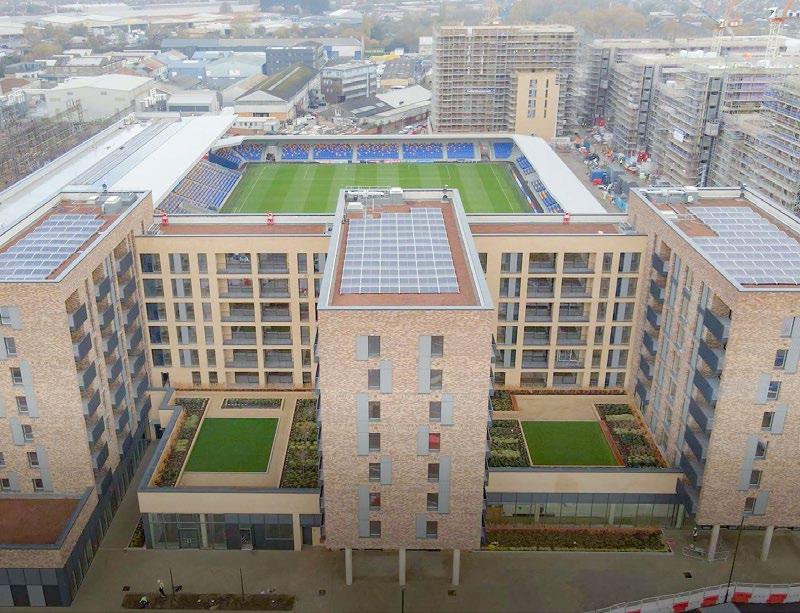
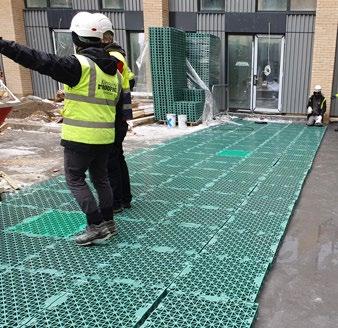

Wimbledon Grounds sets the bar for sustainable residential developments
Written by Fabian Kaiser of Accredited Supplier ZinCo Green Roof Systems
Sustainability and ecology are becoming increasingly important in modern architecture. At the same time, urban planning solutions are urgently required to counteract the consequences of climate change such as heavy rainfall events and overheating of cities. This means that designers and architects will have to focus even more on roofs and podium decks with regard to rainwater management.
The enormous potential associated with this can be illustrated with the huge mixed-use development at Wimbledon Grounds, including a vast 15,967 sqm area of ‘blue’ roofs and ‘blue’ podiums, resulting in one of the largest blue roofing projects in the UK.
The key feature of these blue/green roofs is the ZinCo system build-up “Stormwater Management Roof” which stores large volumes of rainwater and releases them again over predetermined periods and reduces the urban heat island effect by the huge number of greened areas.
The blue/green roofs at Wimbledon Grounds are able to cope with over 1 million litres of water at full capacity. A prime example of urban development for the future.
This large-scale development located on Plough Lane is part of a 51,000 sqm regeneration masterplan for the brandnew purpose-built stadium for AFC Wimbledon. The residential scheme surrounding the stadium comprises 600 homes as well as community, leisure, and retail space. Every roof and podium in the Wimbledon Grounds residential complex is a ‘blue’ roof, which incorporates a Sustainable Urban Drainage System (SuDS) to prevent flooding and pollution. The project includes four large blue podiums with landscaped gardens, providing residents with a community space. In addition, the apartment block roofs have 26 blue roofs with a green roof installed on top. These are seeded with a biodiverse mix of native wildflowers, sedum and grasses. 15 of these blue/green roofs also house farms of solar panels to generate electricity for the complex.
The Wimbledon Grounds blue roofing system works on a cascade system. The blue roofs on the apartment attenuate storm water which is then gradually released by a flow controller over 12-24 hours to the larger reservoir in the four podiums of this building. The outflow from the podiums then also has a controlled release into the urban drainage system. Such measures have become necessary as London’s Victorian sewers are regularly overwhelmed by heavy rain events.
ZinCo system build-up provides flood protection
The ZinCo system build-up “Stormwater Management Roof” for the landscaped podiums consists of special RSX type retention spacers combined with precisely adjustable RDS48 flow controllers, which also function as an overflow. ZinCo filter sheet PV is first installed below the spacer element to protect the waterproofing during construction and in service. The RSX spacer elements are then laid over the top and another layer of PV filter sheet over the spacer elements completes the buildup.
Over the top of this, designers and contractors are free to install soft and hard landscaping alike. The RSX spacers have a load capacity of up to 50 tons which means that even roadways can be constructed above them with the correct construction. At Wimbledon Gardens a mixture of lawns, intensive planting, resin bonded pathways and paving have been installed directly over the RSX attenuation layers.
A different build-up has been used for the blue roofs on the apartment rooftops as they have extensive green roofs over the top. Instead of the heavy-duty RSX type spacer elements, the much lighter retention spacer RS60 was used which has the advantage of drastically reducing cost. A complete extensive green roof over the RS60 spacer using Zinco drainage board Floradrain FD25–E was installed. Due to the lower substrate height on the extensive roofs the additional drainage element is required to allow sufficient permanent retention and supply of water to the plants even in dry periods. The drainage layer for the green roof retains water for the vegetation during hot dry periods but allows excess rainfall through to the blue roof below where it is attenuated, and the outflow controlled.
To make this role model project a success, a close cooperation was required by all involved, and ZinCo would like to thank Galliard Homes, Kingsley Roofing and ZinCo Approved installer and Accredited Contractor Pritchard and Pritchard.
For further information please contact +44(0)1223 853843,
office@zinco-greenroof.co.uk
or visit zinco-greenroof.co.uk
Rathbone Market Amenity Area, London
Water Quantity Water Quality
SuDS Design
Amenity Biodiversity
Met Office climate projections indicate significant temperature rises in the decades ahead, with extreme weather and flooding events becoming more frequent. Summer rain is forecast to become more intense, leading to a greater risk of flash flooding and the trend for wetter winters is also likely to continue, placing greater pressure on existing sewers and flood defences. Traditional roof drainage design allows rainwater to simply run off the building and directly into storm water sewers or natural water courses, and this lack of management is a major factor in the rising number of flood events occurring throughout the country.
Blue roof systems utilise roof and podium space to provide attenuation capacity, rather than quickly moving the water elsewhere. Water
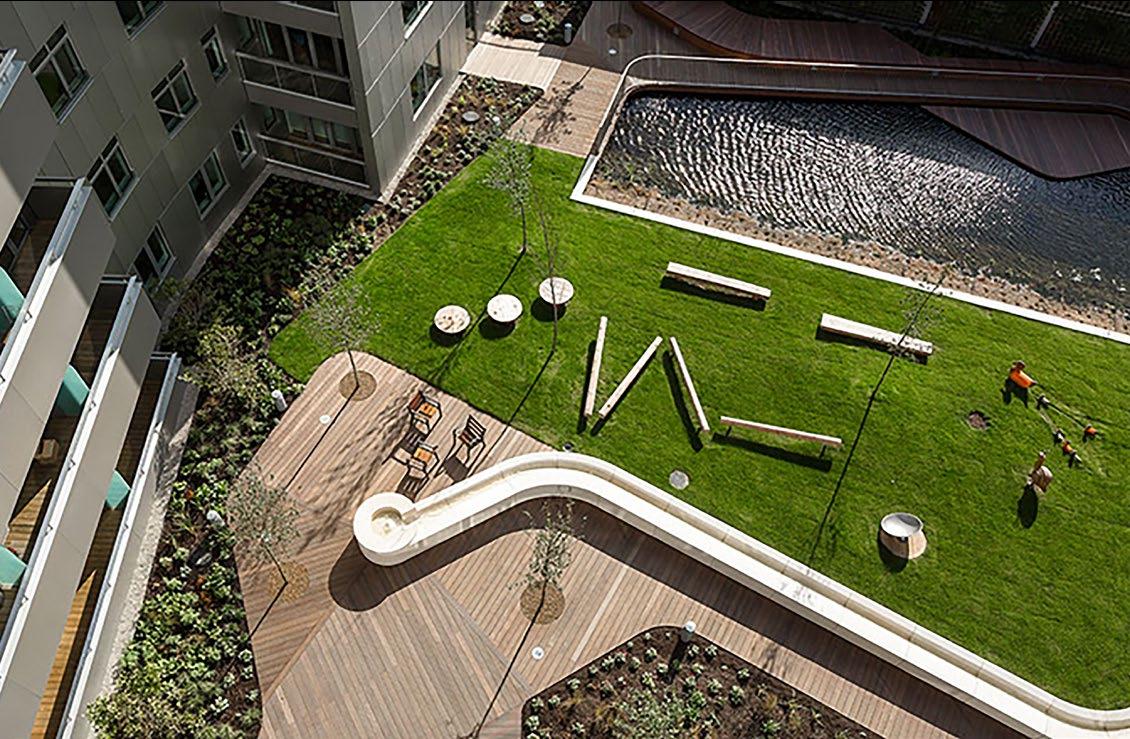
Close up of blue roof build up showing geotextile filters, void formers and height adjustable stainless steel restrictor chamber Blue roofs address the ‘four pillars’/ objectives of good SuDS design
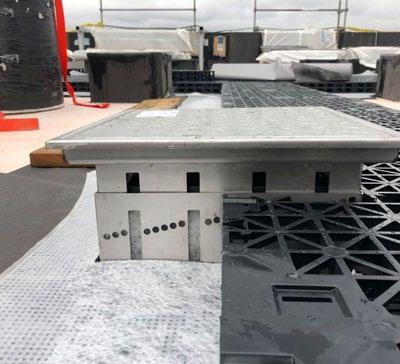
attenuated within the roof area can then be released at a controlled rate through a bespoke restrictor outlet designed to offer variable discharge rates and keep the flow within the limits set by the local authority as part of the discharge consent.
Blue roof systems offer a sustainable alternative to minimising surface water run-off, providing source control as part of the Sustainable Urban Drainage System (SuDS) requirement on modern developments. Blue roofs are rated as the most sustainable technique in the CIRIA SuDS manual guidance based on their contribution to reducing the risk of flooding and pollution and their positive impact on the local landscape and wildlife ecosystems when combined with a green roof finish. With land at a premium, blue roofs allow the developer to maximise usage of any site, especially in city centre developments where underground storage systems are impractical and expensive to excavate.
System configuration
Blue roofs introduce drainage voids and restrictor chambers/orifices within the roof build-up to attenuate and release water at a maximum controlled rate. Under normal rainfall events the roof will continually drain like a normal flat roof. The blue roof storm water management system only comes into effect during a heavy downpour / key design storm event. At this point, the blue roof will slow the rainwater discharge to the agreed maximum rate to help meet the site’s drainage strategy and some patented systems have very effective outfall chambers that combine the flow restrictors with the exceedance overflow to reduce the number of roof penetrations.
Written by Accredited Contractor
Geo Green Solutions

Installation and Maintenance
Blue roof systems should be installed by an experienced and specialist contractor with supervision from the manufacturer, with provision for post installation quality checks and annual maintenance. Recent examples of blue roof installations include prestigious projects such as the Post Building, Royal College of Art and Rathbone Market in London, Middlewood Locks apartments in Manchester and the new Edinburgh St James retail development.
Surface finishes
Blue roofs are suitable for a variety of flat roof surface finishes; including extensive, intensive and biodiverse green roofs, paved and decking areas and for final usage applications such as beneath podium deck amenity and trafficked areas, MUGAs and M&E plant and PV panel locations.
Environmental benefits
When combined with a green roof surface finish, blue roofs help to absorb CO from the atmosphere, 2 reduce urban heat island effect, absorb low frequency sounds and promote new wildlife ecosystems and biodiversity.
Installing a blue roof system also has a positive impact on the quality of the water discharged. Before the water reaches the roof outlet, it passes through several filtration layers that remove particulates and pollutants. Even if the surface finish isn’t green, the water passes through at least two layers of geotextile filtration. The water is treated to such a degree that it usually reaches the level required in treatment train stage one of the SuDS process, allowing water to be released from the roof directly into the river or sewer systems.
Local rainfall/flood data
As part of the SuDS design process for new planning applications, local flood report data is analysed to model and calculate the attenuation capacity required for the roof during storm events. The rainfall for the specific site is calculated according to location, storm duration and return period (the number of times in a set period that a storm of that magnitude is likely to occur; 1 in 30 years and 1 in 100 years storms are usually considered). In the UK, values are taken from either the Flood Studies Report (FSR) or Flood Estimation Handbook (FEH) data, with an allowance made for the impact of future climatic change, typically +40%.
Summary
Blue roofs are rated as one of the most sustainable, ‘at source’ SuDS techniques and can often meet all four of the objectives for good SuDS design. When implemented correctly they form an integral source control and attenuation element for modern developments.
For more information visit
geogreen.co.uk/applications/ blueroof-applications


Composite decking surface finish for amenity area
Extensive green roof finish for promoting new ecosystems
MASSIVE RUN TIME.

36V LXT BRUSHLESS LAWNMOWER: LM001C
PDC01 PDC1200

Approx. mowing area with PDC1200 in push mode: 6900m² Approx. mowing area with PDC01 equipped (4x 6.0ah batteries) in push mode: 2300m²
LM001C is a 530mm battery powered lawn mower powered by 36V high power drive system using the Makita portable power pack PDC01 or PDC1200. Brushless motor, Electric brake, 3x cutting modes to suit surrounding environment, Soft start, Constant speed control, Durable steel deck, Self propelled: On/off switch, Soft no load function, Single lever cutting height adjustment, Child lock key, Grass box with grass level indicator. Handle height adjustment (2 stages), Wheels with built in ball bearing for additional durability, IPX4 Waterproof Design. Voltage 36V, Blade type Rotary type 2 tooth, Cutting diameter 534mm, Cutting heights 10/20-100 Levels/mm, Collection box 70 litres, No Load Speed 2,300-2,800rpm, Net weight 42.1-49.5 kg.
PDC1200

PDC01
Mental health in the construction industry


As awareness of mental health increases, as does recognition of the number of people – family members, friends and colleagues – who may be suffering. Statistics reveal the scale of the problem; one in four people will experience a mental health problem in England each year, whilst one in six people may experience a common mental health problem (such as anxiety or depression) each week in England.
Awareness of mental health is not confined to the UK; throughout the world efforts have been made to answer calls for more support for those suffering, but also learn more about the causes of mental health problems.
Scientific, peer-reviewed research conducted around the world on construction workers has revealed trends which suggest individuals in the industry are at a greater risk. Internationally, construction workers have been found to have significantly higher suicide rates when compared with other workers.
Despite this, construction workers are less likely to seek professional help. This trend is particularly relevant to young men in the construction industry who have traditionally presented themselves as robust and resilient human beings, which is the opposite to research findings undertaken on this group and mental health statistics. Due to the obvious overlap of roles between the construction and landscape industry, research findings are of relevance to Association members.
In a broad review of Dutch construction workers, mental health effects from job roles were measured by assessing issues arising during work, symptoms of distress, depression, and incidences of post-traumatic stress disorder. The research suggests that prevalence of self-reported mental health issues amongst bricklayers and supervisors, respectively, were as follows: high need for recovery after work (14%, 25%), distress (5%, 7%), depression (18%, 20%) and posttraumatic stress disorder (11%, 7%).
Whilst, predictably, high work speed and quantity of work drove stress, low participation in decision making and low social support of supervisors drove depression, as did few learning opportunities, future prospects and poor work-life balance. Supervisors experienced higher levels of psychological demands and reported a higher need for recovery after work.
Research into the causes of poor mental health amongst workers suggests support from supervisors is a key requirement; the absence of support can have a significant impact on mental health. Contractors working on sites away from sources of office-based support reported higher levels of poor mental health than office workers working under stressful conditions, since office workers had easier access to support.
Another aspect of research conducted on the construction industry of relevance to the landscape industry is the close link between injury and the impact this has on construction workers’ mental health. Like building construction work, site-based landscape construction and maintenance work is physically demanding, and incidences of physical injury and work disability are high compared to office-based roles.
In construction, the most frequently reported musculoskeletal complaint is low back pain, with over 40% of construction workers over 50 years reporting chronic back pain. Several research papers have identified a link between poor mental health and persistent low-back pain and suggest workers whose pain originated from work had significantly higher levels of depression, anxiety and stress. Bodily pain creates psychological demands for construction workers which impacts on their mental health and ability to work.
The high level of mental health issues and lack of treatment in the construction industry is concerning, and something the landscape industry should be mindful of. It is hoped increased coverage of the topic has removed the stigma of discussing mental health issues and that the provision of dedicated services ensures those who need help get it.
Written by Owen Baker
Technical Officer (Policy & Research)
Beyond this, however, is a need for intervention from supervisors to manage work levels and ensure a work life balance – which has been identified as a strong predictor of mental health problems – is managed before operatives suffer. Management of this nature is in the best interest of business owners, since research has highlighted the negative correlation between mental health and work quality.
Owen Baker - Technical Officer (Policy & Research)

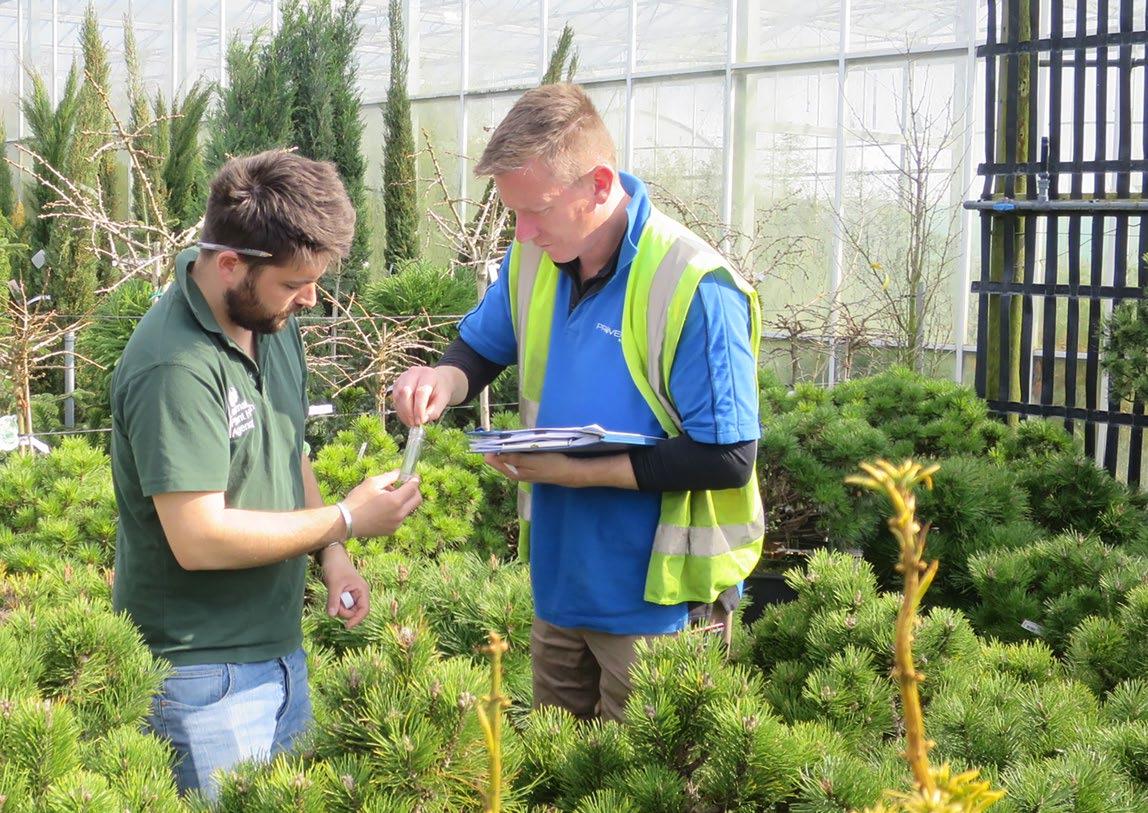
Plants being processed and checked
What does Plant Healthy mean to you?
Written by Provender Nurseries’ Marketing Manager Liz Hughes
Industry standards are of utmost importance to any member of the British Association of Landscape Industries. If you are one of those members who is reading this, that’s why you are a member. These standards hold kudos and customers can select your company with the confidence that you uphold industry guidelines and procedures. You pass the accreditations, business inspection and scrutiny and can now hold your head above the parapet amongst the crowd.
Plant Healthy, which launched in 2020, is a new quality assurance scheme created to protect horticultural supply business against destructive pest and diseases. Plant Healthy has been developed by the industry, with input from government and sets out key requirements for plant health management.

Plant Healthy Certification is to wholesale plant nurseries what the Association’s accreditation is to members. In other words, every plant nursery supplying across the industry should aim to be Plant Healthy certified, regardless of size. Now, as a member, you can select your plant supplier with the same confidence your customers have in you.
Although the Plant Healthy scheme is voluntary, Provender Nurseries decided to undertake the rigorous process to qualify for Plant Healthy status to assure our customers just how important plant health, biosecurity and plant husbandry is to us as a plant supplier.
Having worked closely with Plant Healthy auditors to ensure that the highest standards are met and upheld from the very start of the plant procurement procedure to the moment plants are delivered to the nursery and purchased by our valued clients. Provender Nurseries attained our Plant Healthy certificate early in 2021.
Biosecurity on site at Provender Nurseries
In order to pass the certification Provender Nurseries had to demonstrate traceability of all stock coming to and leaving our nursery in Kent. Many procedures required were already in place and being followed including biosecurity, plant husbandry and staff training.
Being Plant Healthy requires input from all areas of the business due to the wide range of content covered and guidelines to follow. Plant passports, phytosanitary certificates and ensuring the correct import documents are provided by our suppliers for the internal processing of plant orders done by a wide range of people with a myriad of skills on site.
As a business we care passionately about plant procurement so we can offer our customers plants that are clean. Attaining the Plant Healthy certification ensures that our customers have clarity and peace of mind that we are doing our utmost to meet and hold standards of good practice. Each year Provender Nurseries will continue to be audited to ensure those standards are upheld.
Our plant purchasing team can buy and import with confidence following all
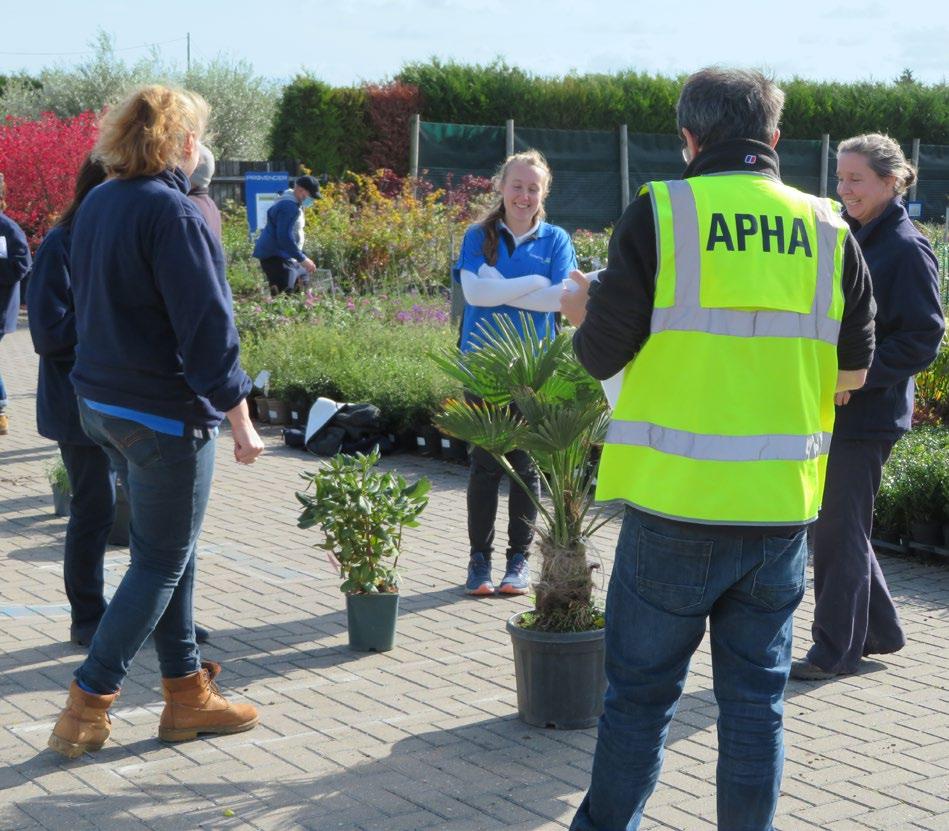
Biosecurity training with APHA at Provender Nurseries
present procedures that we have in place. We can demonstrate traceability of all plant stock both incoming and outgoing while identifying the higher risk lines that we have to take a Pest Risk Analysis which is part of the Department for Environment, Food and Rural Affairs guidelines.
It is not all about importing plants to the cash and carry, a large part of the accreditation process to become Plant Healthy involved checking our plant maintenance, aftercare, spraying regime, feeding regime, pruning timetable, applications of biological control and other general husbandry procedures we already follow on-site as normal.
Here at Provender Nurseries being Plant Healthy certificated is most important to us in terms of education. Educating our sales team, wherever they are within the company, educating our nursery team and keeping all of our staff trained. Staff training involves regular updates for the nursery team, plant purchasers held in house. Each year every member of staff benefits from training sessions held by the Animal and Plant Health Agency on site.
It is not only our staff we need to keep informed, part of our ongoing relationship with horticultural colleges involves talks to students about the importance of plant health. Our sales team and nursery team are justifiably proud of the Plant Healthy certification and the opportunities this accreditation brings to our company.
As part of our ongoing business strategy, being Plant Healthy certificated means that Provender Nurseries can now look at holding events covering biosecurity in general and understanding the processes behind the Plant Healthy scheme and the benefits of buying form an accredited supplier.
We hope to hold events for members of all trade bodies across the industry and expand our presence in the market to clients that require Plant Healthy certification as part of their criteria for their own plant supply procurement requirements.
It is important that as an industry we remain informed, up to date and working with best industry standards as the norm. Being audited each year

Zohreh pruning
highlights the need to stay on our toes and keep up to date with any relevant changes. As a result of the initial audit, we are producing a Nursery Manual for all new staff to use for reference and training purposes.
With an excellent reputation within the industry, we work hard to uphold a strong working relationship with both the APHA and Plant Healthy scheme.
Looking ahead, our clients can rest assured that Provender Nurseries are doing all we can to keep the industry healthy and stay Plant Healthy. As time progresses it would be great to see plant nursery suppliers of all sizes become part of the Plant Healthy scheme.
For information on the Plant Healthy scheme visit planthealthy.org.uk or to read more about the work undertaken at Provender Nurseries visit provendernurseries.co.uk









